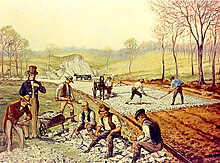Carl Rakeman
Carl Rakeman (born April 27, 1878 in Washington, DC , † February 21, 1965 in Fremont , Ohio ) was an American painter and printmaker .
life and work
Rakeman, son of the German-American still life and wall painter Joseph Rakeman [n] (1832–1917) , who was born in Melle and immigrated in 1856, and his wife Eva, received artistic training from his father, who had temporarily assisted the painter Constantino Brumidi , and from Corcoran School of Art in his hometown. He also studied in Düsseldorf , Munich and Paris . In 1913, Eliphalet Frazer Andrews , former director of the Corcoran School of Art, selected Rakeman from among the students to copy portraits of President Rutherford B. Hayes and his wife. Another early commissioned work was the design of a poster for the American Red Cross around 1918 . On December 12, 1919, Rakeman married Linda Heinline, daughter of William Heinline of Sandusky County , Ohio.
In 1921 he became an employee of the United States Department of Agriculture , which at the time also directed the Bureau of Public Roads , a predecessor organization of the Federal Highway Administration . There, Rakeman was responsible for producing exhibits for various exhibitions and fairs, in particular for the Brazilian Exposition (1922), the A Century of Progress in Chicago (1933), an international exhibition in Paris, and the Golden Gate International Exposition in San Francisco (1939 ) and the New York World's Fair (1939/1940). In the course of his employment he also painted 109 pictures depicting historic highways, highways and railways in the United States. In the Senate Committee Room on Appropriations of the Capitol , he created lunette frescoes over the windows, doors and fireplace, on which the generals George Washington , Anthony Wayne , Joseph Warren and Horatio Gates are portrayed. In addition to Washington, his works have been preserved in the US Soldiers Home (Tennessee), the Ohio State House (Columbus) and the Hayes Memorial Museum . In 1952, Rakeman resigned from service with the Bureau of Public Roads . He retired to Fremont, Ohio, where he died in 1965.
literature
- Peter C. Merrill: German Immigrant Artists in America. A Biographical Dictionary . Scarecrow Press, 1996, ISBN 978-0-8108-3266-4 , p. 213
Web links
- The Paintings of Carl Rakeman , biography in the portal fhwa.dot.gov ( Federal Highway Administration )
- Rakeman, Carl , short biography in the portal rbhyes.org
Individual evidence
- ↑ Bettina Baumgärtel , Sabine Schroyen, Lydia Immerheiser, Sabine Teichgröb: Directory of foreign artists. Nationality, residence and studies in Düsseldorf . In: Bettina Baumgärtel (Hrsg.): The Düsseldorf School of Painting and its international impact 1819–1918 . Michael Imhof Verlag, Petersberg 2011, ISBN 978-386568-702-9 , Volume 1, p. 438
| personal data | |
|---|---|
| SURNAME | Rakeman, Carl |
| BRIEF DESCRIPTION | American painter and printmaker |
| DATE OF BIRTH | April 27, 1878 |
| PLACE OF BIRTH | Washington, DC |
| DATE OF DEATH | February 21, 1965 |
| Place of death | Fremont , Ohio |

